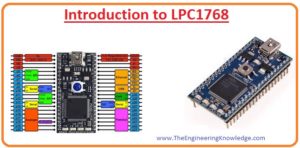 Hello, readers welcome to another new interesting post. In today’s post, we will have a detailed look at Introduction to LPC1768. It is ARM Cortex M3 based controller that is used in an embedded system for such projects that needed less power. The core of this module which is Cortex-M3 which is the advanced level core provides different types of features such as debugging and support block integration of advanced level. It operates on the frequency of one hundred megahertz.
Hello, readers welcome to another new interesting post. In today’s post, we will have a detailed look at Introduction to LPC1768. It is ARM Cortex M3 based controller that is used in an embedded system for such projects that needed less power. The core of this module which is Cortex-M3 which is the advanced level core provides different types of features such as debugging and support block integration of advanced level. It operates on the frequency of one hundred megahertz.
This device is incorporated with the three-stage pipeline and supported the Harvard architecture. In today’s post will discuss its pinout, application, features, and some other related parameters. So let’s get started with Introduction to LPC1768.
Introduction to LPC1768
- The LPC1768 is a type of microcontroller which generally used in different types of electronic and embedded system projects.
- This module comprises of the inner flash memory unit of having space of five twelve kilobytes with a has static random access memory of sixty-four kilobytes.
- Due to large size memory units it mostly preferred for such applications that needed a large amount of data storage.
- It also prefers for such applications that needed a high speed of almost one hundred megahertz.
- It also comes with the transformation twelve-bit having an eight-channel analog to digital converter.
- With that this module comprises of ten-bit digital to analog converter, for controlling of motor has pulse width modulation, RTC connected on this board which is compatible with the SPI, I2C protocols.
- There are different types of inputs and outputs pinouts are exist on this board to do different operations.
- To store and transfer of data through this board, there is SD card socket is connected on this board.
- To regulation and transfer of different categories of data and information between the computer and this board, it comprises of ethernet LAN 10/100megabyte connection.
- There is a high speed 2.0 connection of USB is given at this board which operates as the sender and receiver of data.
- The best feature it provides is 240 by 320 TFT touch screen liquid crystal display and resolution of this LCD is sixty-five thousand five hundred thirty-six bits.
Features of LPC1768
- These are some important feature of this board which is discussed here with the details.
- It comprises of ARM-based Cortex-M3 based CPU operating at a frequency value of one hundred megahertz.
- It consists of five hundred twelve kilobyte space flash memory units.
- It comprises of thirteen by sixteen-kilo byte static random access memory unit.
- It consists of GPDMA having eight channels that used to support SSP, I2S bus, UART, and A/D and D/A converters.
- It comprises of Ethernet MAC having RMII interfacing, with that has 2.0 high-speed USB port,.
- There are 4 UART are connected on this board with that inner FIFO.
- It has CAN protocol with a two-byte controller having 2 channels.
- There is SPI communication protocol, serial and duplex communication is completed on it.
- There are 2 SSP controller are assembled on this board. This interfacing can be manipulated with the general-purpose DMA.
- There are seventy pinouts is exited on this board,
- There is twelve bit analog to digital converter is connected on this module. and four-timer included.
- It can operate in the voltage range of 2.4 to 3.3 volts.
- Its physical dimension are in the range of (14 × 14 × 1.4) millimeter.
Applications of LPC1768
- These are some common applications of this module discuss here.
- It used in different types of alarm systems.
- It used in the lighting system,
- In industries circuits of different machines comprises of this board,
- It used for speed control of the motor.
That is a detailed post about LPC1768 if you have any further queries ask in the comments. thanks for reading.







